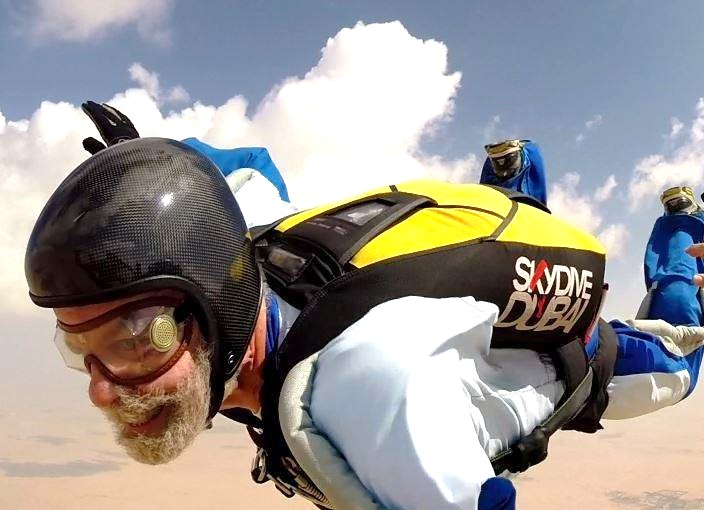After almost a 25-year hiatus, I came back into the fold, enabled by the last child having gone off to college, and prompted by arthritic hips that were making it too painful to play tennis. I figured some things may have changed, but that I had been aware of them, having kept up my USPA membership and subscription to Parachutist. Well, it’s one thing to be aware of something, and quite another to learn to handle it in real time. In my first year back, I jumped at 5 different dropzones in three countries, so that I saw how the changes have been implemented in some different environments. Here is a list of the things that had changed that awaited my return, and had implications for my safety and the safety of others. 1. There are seatbelts in these jumpships—a good idea in the event of an unanticipated landing, but one has to learn where they are, remember to take them off, to stow them (especially in small aircraft), and be aware of where they are to avoid entanglement on exit. 2. Spotting is a thing of the past in many dropzones—just keep your eye on the colored lights! Still, it is a good idea to check where one is, in the event a pilot was tracking the wrong line. 3. Turbine aircraft now have doors! No more freezing on the way to altitude, or clinging to one’s neighbor to avoid falling out. However, one has to learn when they go up and down, how to secure them, how to close them gently. 4. Everyone wears their pilot chute above their butt—making deployment a little slower, if one manages to find it (remember the advert in the Parachutist: “Looking for something?”), but avoiding a few other problems. Be sure to practice deployment with the gear you will be using many times on the ground, in a prone position, to develop some muscle memory before going up. And check it constantly—my too-loose BOC pouch let out my pilot chute when I rose from the floor and caught it on something, much to the consternation of the planeload of jumpers whose lives I had just endangered. 5. Parachutes come in many flavors, and many sizes—gone are the days of one canopy fits all. Most of today’s canopies are very touchy, and downright skittish, react to the slightest input, and take far more concentration in the last few hundred feet of descent. Everybody swoops, to some degree, and some DZs have abandoned upkeep of their pea gravel because nobody uses it. I found it easier to land an original Sabre 170 than a Sabre II 190, and I am sure I will not be going for a fully elliptical canopy—at my age, I have to avoid the 1-in-500 jump mishaps that can maim one for life. Essentially, skydivers have invented a whole new way to die—turn low, and drive into the ground at 60mph. 6. There are many minor innovations in skydiving gear, too many to mention—just make sure you know how everything works on your rig, and why it is the way it is. 7. Everybody PRO-packs, or uses some variant—although I had had several people show me how to do it, and watched all the videos, etc., in my first dozen attempts, I packed one malfunction, and had to get more private instruction in a quiet place. 8. People fly landing patterns—e.g. left-hand, with turns at 1000, 600, 300 feet--in the old days, even with 20 jumpers in the air, we all did pretty much what we wanted and hoped for the best; now, even a 4-way requires paying attention to the landing pattern. 9. Breakoff for belly-flying is much higher—instead of separating an 8-way at 3500, now 4500 or even 5000 is the time to say goodbye. Coupled with the higher minimum opening altitude of 2500, this makes for a much more reasonable margin for error—and as humans, we are prone to error. 10. There are now many different skydiving disciplines, and you have to learn about them, and pay attention to exit order, as one jump run may let out belly flyers, freeflyers, angle flyers, trackers, wingsuiters, and tandems, as well as people who haven’t made up their mind before boarding exactly what they are planning to do. 11. AADs are now required most places—no longer shunned as devices that might blow up in your face. RSLs are also ubiquitous—both systems have saved many, many lives. 12. There are lots of old jumpers now—few old bold ones—and they have learned a lot about how to be safe over their last quarter century, while I’ve been taking kids to soccer practice. Pepper them with all sorts of questions, and do not rush to emulate the 22-year-olds out there. They likely have gone through a much more comprehensive training program than you have, including courses on canopy control and instruction on equipment safety. My personal rule, which I have not seen enunciated elsewhere:
On any given jump, DO NOT INTRODUCE MORE THAN ONE NEW PIECE OF EQUIPMENT, or new way of using a piece of equipment. Of course, your first couple of recurrency jumps will necessitate breaking this rule—but don’t go out of your way to put a camera on, or add anything other than what is absolutely necessary. Example: If you get a new jumpsuit, don’t also try a new helmet on the same jump. Or, if you do, go out on a solo jump. Addendum: Do your homework. I recently was caught in a dust devil at 100ft or so, which completely collapsed my canopy, and I credit my reactions and walk-away landing to a video and a book, both by Brian Germain, which I had studied in detail. Larry Moulton, C-11371, EET #22, is a professor of international health and biostatistics at Johns Hopkins University.


